| Listing 1 - 9 of 9 |
Sort by
|

ISBN: 0691160309 129970641X 0691160317 0691114404 1400848733 0691114412 9780691160306 9780691160313 9780691114408 9780691114415 Year: 2013 Publisher: Princeton: Princeton university press,
Abstract | Keywords | Export | Availability | Bookmark
 Loading...
Loading...Choose an application
- Reference Manager
- EndNote
- RefWorks (Direct export to RefWorks)
Publisher's description: How can the future number of deer, agricultural pests, or cod be calculated based on the present number of individuals and their age distribution? How long will it take for a viral outbreak in a particular city to reach another city five hundred miles away? In addressing such basic questions, ecologists today are as likely to turn to complicated differential equations as to life histories--a dramatic change from thirty years ago. Population ecology is the mathematical backbone of ecology. Here, two leading experts provide the underlying quantitative concepts that all modern-day ecologists need. John Vandermeer and Deborah Goldberg show that populations are more than simply collections of individuals. Complex variables such as the size distribution of individuals and allotted territory for expanding groups come into play when mathematical models are applied. The authors build these models from the ground up, from first principles, using a much broader range of empirical examples--from plants to animals, from viruses to humans--than do standard texts. And they address several complicating issues such as age-structured populations, spatially distributed populations, and metapopulations. Beginning with a review of elementary principles, the book goes on to consider theoretical issues involving life histories, complications in the application of the core principles, statistical descriptions of spatial aggregation of individuals and populations as well as population dynamic models incorporating spatial information, and introductions to two-species interactions. Complemented by superb illustrations that further clarify the links between the mathematical models and biology, Population Ecology is the most straightforward and authoritative overview of the field to date. It will have broad appeal among undergraduates, graduate students, and practicing ecologists.
Population biology --- Ecology --- Mathematical models --- Mathematical models. --- Biologie des populations --- Ecologie --- Modèles mathématiques --- 574.3 --- 574.3 Populations and environment. Population dynamics --- Populations and environment. Population dynamics --- Population biology - Mathematical models --- Ecology - Mathematical models
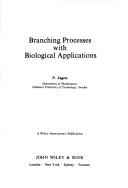
ISBN: 0471436526 9780471436522 Year: 1975 Publisher: London: Wiley,
Abstract | Keywords | Export | Availability | Bookmark
 Loading...
Loading...Choose an application
- Reference Manager
- EndNote
- RefWorks (Direct export to RefWorks)
Biomathematics. Biometry. Biostatistics --- Stochastic processes --- Population biology --- Mathematical models --- 519.218 --- Branching processes --- -Biology --- Ecology --- Processes, Branching --- Special stochastic processes --- Branching processes. --- Mathematical models. --- -Special stochastic processes --- 519.218 Special stochastic processes --- -Processes, Branching --- Markov processes. --- Markov, Processus de. --- Markov, Processus de --- Processus stochastiques --- Population biology - Mathematical models --- Biomathematique
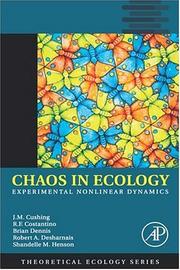
ISBN: 0121988767 9786611027131 1281027138 0080528872 9780121988760 9780080528878 Year: 2003 Publisher: Amsterdam : Boston : Academic Press,
Abstract | Keywords | Export | Availability | Bookmark
 Loading...
Loading...Choose an application
- Reference Manager
- EndNote
- RefWorks (Direct export to RefWorks)
It is impossible to predict the exact behavior of all biological systems and how these same systems are exemplified by patterns of complexity and regularity. Decades of research in ecology have documented how these sorts of patterns are the consequences of deceptively simple rules that determine the nature of the patterns created. Chaos in Ecology will explain how simple beginnings result in complicated results.Chaos in Ecology is the inaugural volume of Theoretical Ecology Series. The authors of this volume have employed data from a proven model system in population dyn
Ecology --- Population biology --- Chaotic behavior in systems --- Nonlinear theories --- Mathematical models --- Chaotic behavior in systems. --- Nonlinear theories. --- Nonlinear problems --- Nonlinearity (Mathematics) --- Calculus --- Mathematical analysis --- Mathematical physics --- Chaos in systems --- Chaos theory --- Chaotic motion in systems --- Differentiable dynamical systems --- Dynamics --- System theory --- Mathematical models. --- Ecology - Mathematical models --- Population biology - Mathematical models
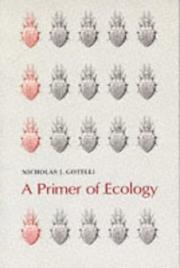
ISBN: 0878932704 9780878932702 Year: 1995 Publisher: Sunderland (Mass.) : Sinauer associates,
Abstract | Keywords | Export | Availability | Bookmark
 Loading...
Loading...Choose an application
- Reference Manager
- EndNote
- RefWorks (Direct export to RefWorks)
General ecology and biosociology --- Ecology --- Population biology --- Mathematical models --- Population animale --- Animal population --- Population végétale --- plant population --- Biogéographie --- Biogeography --- Structure de la population --- population structure --- Dynamique des populations --- population dynamics --- Compétition biologique --- Biological competition --- Modèle --- Models --- Technique de prévision --- Forecasting --- 574.34 --- 591.5 --- -Population biology --- -Biology --- Balance of nature --- Biology --- Bionomics --- Ecological processes --- Ecological science --- Ecological sciences --- Environment --- Environmental biology --- Oecology --- Environmental sciences --- Population dynamics --- Animal habits. Animal behaviour. Ecology. Ethology. Animal and environment. Bionomy --- Mathematical models. --- -Population dynamics --- 591.5 Animal habits. Animal behaviour. Ecology. Ethology. Animal and environment. Bionomy --- 574.34 Population dynamics --- -591.5 Animal habits. Animal behaviour. Ecology. Ethology. Animal and environment. Bionomy --- Population biology - Mathematical models --- Ecology - Mathematical models --- Population biology. Mathematical models
Book
ISBN: 146141685X 1461416868 9781461416852 Year: 2011 Publisher: New York: Springer,
Abstract | Keywords | Export | Availability | Bookmark
 Loading...
Loading...Choose an application
- Reference Manager
- EndNote
- RefWorks (Direct export to RefWorks)
This textbook provides an introduction to the field of mathematical biology through the integration of classical applications in ecology with more recent applications to epidemiology, particularly in the context of spread of infectious diseases. It integrates modeling, mathematics, and applications in a semi-rigorous way, stating theoretical results and giving references but not necessarily giving detailed proofs, providing a solid introduction to the field to undergraduates (junior and senior level), graduate students in applied mathematics, ecology, epidemiology or evolutionary biology, sustainability scientists, and to researchers who must routinely read the practical and theoretical results that come from modeling in ecology and epidemiology. This new edition has been updated throughout. In particular the chapters on epidemiology have been updated and extended considerably, and there is a new chapter on spatially structured populations that incorporates dispersal. The number of problems has been increased and the number of projects has more than doubled, in particular those stressing connections to data. In addition some examples, exercises, and projects include use of Maple and Matlab. Review of first edition: "A strength of the book is the large number of biologically-motivated problem sets. These and the references to the original biological papers would be valuable resources for an instructor." (UK Nonlinear News, 2001).
Epidemiology -- Mathematical models. --- Population biology -- Mathematical models. --- Population biology --- Epidemiology --- Biology --- Health & Biological Sciences --- Biology - General --- Mathematical models --- Mathematical models. --- Mathematics. --- Community ecology, Biotic. --- Biomathematics. --- Mathematical and Computational Biology. --- Community & Population Ecology. --- Ecology. --- Balance of nature --- Bionomics --- Ecological processes --- Ecological science --- Ecological sciences --- Environment --- Environmental biology --- Oecology --- Environmental sciences --- Ecology --- Modelización (4194220) --- Bibliografía recomendada --- Biocenoses --- Biocoenoses --- Biogeoecology --- Biological communities --- Biomes --- Biotic community ecology --- Communities, Biotic --- Community ecology, Biotic --- Ecological communities --- Ecosystems --- Natural communities --- Mathematics
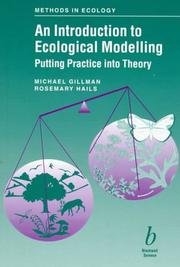
ISBN: 0632036346 9780632036349 Year: 1995 Publisher: Oxford: Blackwell,
Abstract | Keywords | Export | Availability | Bookmark
 Loading...
Loading...Choose an application
- Reference Manager
- EndNote
- RefWorks (Direct export to RefWorks)
574.5 --- 574.34 --- Ecology --- -Population biology --- -#WDIR:wbse --- Biology --- Balance of nature --- Bionomics --- Ecological processes --- Ecological science --- Ecological sciences --- Environment --- Environmental biology --- Oecology --- Environmental sciences --- Population biology --- 574.34 Population dynamics --- Population dynamics --- 574.5 Hydrobiology. Aquatic biocoenoses and ecosystems. Food chains --- Hydrobiology. Aquatic biocoenoses and ecosystems. Food chains --- Mathematical models --- #WDIR:wbse --- Population biology - Mathematical models --- Ecology - Mathematical models --- ECOLOGY --- POPULATION BIOLOGY --- MATHEMATICAL MODELS
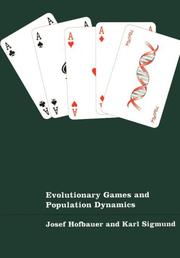
ISBN: 0521623650 052162570X 9780521625708 9780521623650 9781139173179 Year: 1998 Publisher: Cambridge: Cambridge university press,
Abstract | Keywords | Export | Availability | Bookmark
 Loading...
Loading...Choose an application
- Reference Manager
- EndNote
- RefWorks (Direct export to RefWorks)
population dynamics --- Mathematical models --- Dynamic models --- biology --- genetics --- ecology --- Evolution (Biology) --- Game theory --- Population biology --- Volterra equations --- 519.83 --- 519.83 Theory of games --- Theory of games --- Equations, Volterra --- Integral equations --- Games, Theory of --- Mathematics --- General ecology and biosociology --- Game theory. --- Volterra equations. --- Mathematical models. --- Evolution --- Game Theory. --- Models, Theoretical. --- Population Dynamics. --- Evolution (Biologie) --- Biologie des populations --- Théorie des jeux --- Volterra, Equations de --- Modèles mathématiques --- Evolution (Biology) - Mathematical models --- Population biology - Mathematical models --- Equation lotka-volterra
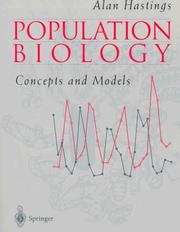
ISBN: 0387948538 0387948627 1475727313 9780387948621 9780387948539 Year: 1997 Publisher: New York : Springer,
Abstract | Keywords | Export | Availability | Bookmark
 Loading...
Loading...Choose an application
- Reference Manager
- EndNote
- RefWorks (Direct export to RefWorks)
Population biology has been investigated quantitatively for many decades, resulting in a rich body of scientific literature. Ecologists often avoid this literature, put off by its apparently formidable mathematics. This textbook provides an introduction to the biology and ecology of populations by emphasizing the roles of simple mathematical models in explaining the growth and behavior of populations. The author only assumes acquaintance with elementary calculus, and provides tutorial explanations where needed to develop mathematical concepts. Examples, problems, extensive marginal notes and numerous graphs enhance the book's value to students in classes ranging from population biology and population ecology to mathematical biology and mathematical ecology. The book will also be useful as a supplement to introductory courses in ecology.
Biomathematics. Biometry. Biostatistics --- General ecology and biosociology --- Population biology --- Biologie des populations --- Mathematical models. --- Modèles mathématiques --- Mathematical models --- Population animale --- Animal population --- Population végétale --- plant population --- Dynamique des populations --- population dynamics --- Modèle --- Models --- 575 --- -#WDIR:wbse --- Biology --- Ecology --- General genetics. General cytogenetics. Immunogenetics. Evolution. Speciation. Phylogeny --- Life sciences. --- Ecology. --- Animal ecology. --- Community ecology, Biotic. --- Conservation biology. --- Environmental sciences. --- Life Sciences. --- Community & Population Ecology. --- Theoretical Ecology/Statistics. --- Animal Ecology. --- Math. Appl. in Environmental Science. --- Conservation Biology/Ecology. --- 575 General genetics. General cytogenetics. Immunogenetics. Evolution. Speciation. Phylogeny --- Modèles mathématiques --- #WDIR:wbse --- Ecology . --- Nature conservation --- Environmental science --- Science --- Animals --- Zoology --- Biocenoses --- Biocoenoses --- Biogeoecology --- Biological communities --- Biomes --- Biotic community ecology --- Communities, Biotic --- Community ecology, Biotic --- Ecological communities --- Ecosystems --- Natural communities --- Balance of nature --- Bionomics --- Ecological processes --- Ecological science --- Ecological sciences --- Environment --- Environmental biology --- Oecology --- Environmental sciences --- Population biology - Mathematical models --- Modele lotka-volterra --- Modele logistique --- Modele de cole --- Modele nicholson-bailey --- Modele epidemic
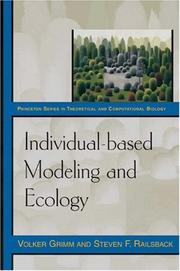
ISBN: 069109666X 9780691096667 9780691096650 0691096651 1400850622 9781400850624 Year: 2005 Publisher: Princeton : Princeton University Press,
Abstract | Keywords | Export | Availability | Bookmark
 Loading...
Loading...Choose an application
- Reference Manager
- EndNote
- RefWorks (Direct export to RefWorks)
Individual-based models are an exciting and widely used new tool for ecology. These computational models allow scientists to explore the mechanisms through which population and ecosystem ecology arises from how individuals interact with each other and their environment. This book provides the first in-depth treatment of individual-based modeling and its use to develop theoretical understanding of how ecological systems work, an approach the authors call "individual-based ecology.? Grimm and Railsback start with a general primer on modeling: how to design models that are as simple as possible while still allowing specific problems to be solved, and how to move efficiently through a cycle of pattern-oriented model design, implementation, and analysis. Next, they address the problems of theory and conceptual framework for individual-based ecology: What is "theory"? That is, how do we develop reusable models of how system dynamics arise from characteristics of individuals? What conceptual framework do we use when the classical differential equation framework no longer applies? An extensive review illustrates the ecological problems that have been addressed with individual-based models. The authors then identify how the mechanics of building and using individual-based models differ from those of traditional science, and provide guidance on formulating, programming, and analyzing models. This book will be helpful to ecologists interested in modeling, and to other scientists interested in agent-based modeling.
Biomathematics. Biometry. Biostatistics --- Human ecology. Social biology --- Population Dynamics --- Models, Theoretical --- Ecology --- Population biology --- Biotic communities --- Biologie des populations --- Mathematical models --- Modèles mathématiques --- Mathematical models. --- Modèles mathématiques --- Ecology. --- Models, Theoretical. --- Population Dynamics. --- Demographic Aging --- Demographic Transition --- Optimum Population --- Population Decrease --- Population Pressure --- Population Replacement --- Population Theory --- Residential Mobility --- Rural-Urban Migration --- Stable Population --- Stationary Population --- Malthusianism --- Neomalthusianism --- Aging, Demographic --- Decrease, Population --- Decreases, Population --- Demographic Transitions --- Dynamics, Population --- Migration, Rural-Urban --- Migrations, Rural-Urban --- Mobilities, Residential --- Mobility, Residential --- Optimum Populations --- Population Decreases --- Population Pressures --- Population Replacements --- Population Theories --- Population, Optimum --- Population, Stable --- Population, Stationary --- Populations, Optimum --- Populations, Stable --- Populations, Stationary --- Pressure, Population --- Pressures, Population --- Replacement, Population --- Replacements, Population --- Residential Mobilities --- Rural Urban Migration --- Rural-Urban Migrations --- Stable Populations --- Stationary Populations --- Theories, Population --- Theory, Population --- Transition, Demographic --- Transitions, Demographic --- Life History Traits --- Genetics, Population --- Experimental Model --- Experimental Models --- Mathematical Model --- Model, Experimental --- Models (Theoretical) --- Models, Experimental --- Models, Theoretic --- Theoretical Study --- Mathematical Models --- Model (Theoretical) --- Model, Mathematical --- Model, Theoretical --- Models, Mathematical --- Studies, Theoretical --- Study, Theoretical --- Theoretical Model --- Theoretical Models --- Theoretical Studies --- Computer Simulation --- Systems Theory --- Environmental Science --- Bionomics --- Ecologies --- Environmental Sciences --- Science, Environmental --- Sciences, Environmental --- Environmental Psychology --- Conservation of Natural Resources --- Environmental Health --- Ecosystem --- Balance of nature --- Biology --- Ecological processes --- Ecological science --- Ecological sciences --- Environment --- Environmental biology --- Oecology --- Environmental sciences --- Population biology - Mathematical models --- Biotic communities - Mathematical models
| Listing 1 - 9 of 9 |
Sort by
|

 Search
Search Feedback
Feedback About UniCat
About UniCat  Help
Help News
News